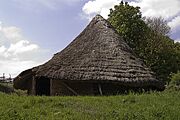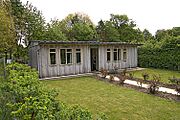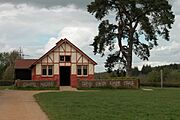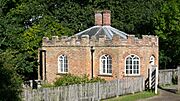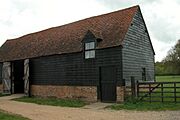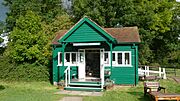Chiltern Open Air Museum facts for kids
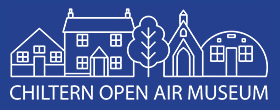 |
|

Examples of a cottage and a prefabricated chapel at the Chiltern Open Air Museum
|
|
| Lua error in Module:Location_map at line 420: attempt to index field 'wikibase' (a nil value). | |
| Established | 1976 |
|---|---|
| Location | Chalfont St. Giles, Buckinghamshire, England, UK |
| Type |
|
| Collections | Reconstructed vernacular buildings from the Chiltern Hills region |
| Public transit access | |
The Chiltern Open Air Museum (COAM) is a special outdoor museum located near Chalfont St Peter and Chalfont St. Giles in the Chiltern Hills, Buckinghamshire, England. It's a fun place to visit and learn about history!
This museum saves and rebuilds old buildings from the Chiltern Hills area. These buildings might have been destroyed otherwise. The museum is a registered charity, meaning it's a non-profit organization. It has a small team of staff and about 200 volunteers who help keep everything running.
Contents
Discovering the Museum's History
The Chiltern Open Air Museum was started in 1976 and first opened its doors to visitors in 1981. Its main goal is to rescue and restore old English buildings from the Chilterns region. These buildings are often at risk of being torn down.
Saving Historic Buildings
The museum carefully takes apart these old buildings. Then, they move them to the museum's large 45-acre site. This site includes beautiful woodlands and parkland. The museum has more than 35 buildings that you can explore. These include old barns, traditional farm buildings, and houses. There's even a working historic farm with real farm animals!
The museum wants to show how people lived in the past. They connect the history of people and places in the Chilterns to today.
Exploring Unique Structures
The museum has many interesting buildings to see. You can find a 1940s prefab house from Amersham. There's also a rebuilt Iron Age house, showing how people lived thousands of years ago. A Victorian toll house from High Wycombe is on display. This was where people paid to use a road long ago.
You can also see a "Tin Chapel" from Henton, Oxfordshire. There's a forge from Garston, Hertfordshire, where blacksmiths used to work. A pair of cottages from Leagrave started as a barn in the 1700s. Later, they were turned into two homes for workers. A chair factory from High Wycombe shows the area's history of making chairs.
The museum also has a rebuilt World War I Nissen hut and a World War II Nissen hut. Next to them, you can see a 'Dig for Victory' garden. This shows how people grew their own food during the wars. In 2014, the museum finished rebuilding a farmhouse from Haddenham. It had been stored for 30 years until enough money was raised.
Future Projects and Famous Connections
The museum also has 16 buildings stored away. They are waiting to be rebuilt when the museum has enough money. One of these is Jackson Studios. This was a famous recording studio used by many well-known artists.
The studio was set up by the sons of Jack Jackson, a famous BBC Radio DJ. Many artists recorded there, including Elton John, Ian Dury, Dr Feelgood, and Motörhead. Motörhead even recorded their famous album Ace of Spades at Jackson Studios! The studio closed when digital music technology became popular. Now, the dismantled studio building is stored at the museum. They hope to rebuild it when they have the funds.
Hands-On Activities and Awards
At the museum, you can try many hands-on activities. You can learn traditional skills like blacksmithing and willow weaving. There are also straw plaiting, historic cooking, and folk singing experiences. The museum hosts many annual events, including re-enactments and living history days.
The museum is very popular with school groups. It has won awards like the Sandford Award and the Learning Outside the Classroom Quality Badge. In 2018, it was even shortlisted for a Museums + Heritage Award for its education programs. The museum also cares about the environment. In June 2013, it won the environmental category of the Pride of Bucks award.
Structures in the collection
See also
- List of museums in Buckinghamshire
- List of open-air and living museums


